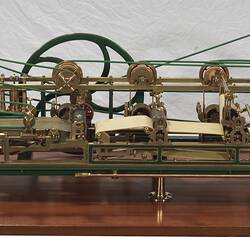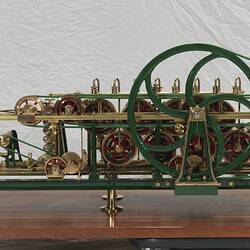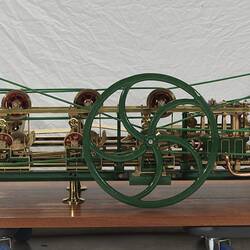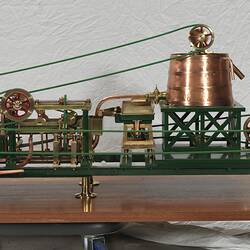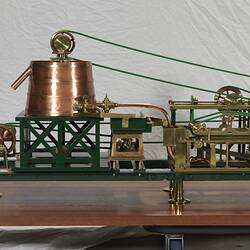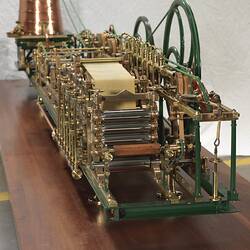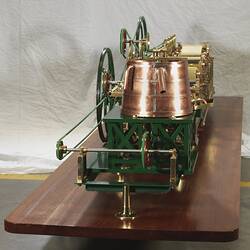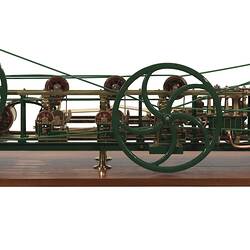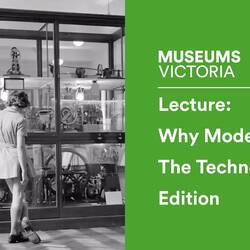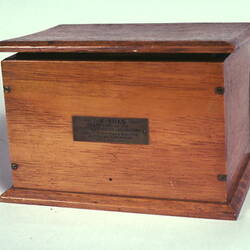Summary
This working miniature, continuous paper making machine was used by researchers for developing the paper making industry in Australia.
In 1920, scientists in the newly formed Commonwealth Institute of Science & Industry (later CSIRO) Forest Products Laboratory began developing techniques for producing paper from local Australian hardwood pulp using this machine. The machine was purchased for the laboratory by a conglomerate of Perth newspaper proprietors. At that time there had been little success in making paper from hardwoods and paper was mostly imported with some local manufacture from imported softwoods. The success of the experimental work on this machine led to trials on a commercial machine in Fyansford, Victoria. By 1941 commercial paper production from eucalyptus pulp had begun at newly built mills in Victoria and Tasmania.
The machine was also displayed as a working exhibit at various industry and educational fairs in Victoria and Tasmania throughout the 1940s-1980s. Former CSIRO staff members fondly remember its location outside the office of Dr Huntly Higgins, during the 1950s and 1960s. After its final use for a demonstration paper making tour of Tasmania in the 1980s, it was put into storage. It returned to Melbourne in the mid-1990s and was restored to operating condition by John Day, a retired University of Melbourne instrument technician. Between 1996 and 2014 it was displayed in the foyer of the Ian Wark Laboratory at CSIRO Administration offices in Clayton. In 2010 it was used at the commemoration ceremony of the Engineering Heritage National Landmark for the Boyer Newsprint Mill.
The machine was manufactured by London firm T.J. Marshall & Co of Belfast Road, Stoke Newington, North London. Its design is based on the Fourdrinier style of paper making machine and this machine is believed to have been first constructed for demonstration of paper making at fairs and exhibitions, including an 1886 printing and stationery exhibition in Edinburgh. It was based on a 1-12th scale of a medium sized commercial paper making machine.
Physical Description
Constructed primarily from metal (copper, bronze, brass, steel). Some metal parts are painted green or red. Fabric gauze belting for paper support. Rubber lined rollers. Polyester or leather belting used for driving wheels. Fixed to solid wood display board with glass case cover.
Significance
This paper-making machine was central to the establishment of the eucalyptus pulping and paper-making industry in Australia and is associated with the early years of the CSIR Division of Forestry Products. The machine was used to prove and then demonstrate the feasibility of paper manufacture (including newsprint) using locally sourced wood pulp from hardwoods which began to be produced commercially in the 1930s. The impact of this development and the use of old-growth eucalypt forest is of particular economic and social significance in Victoria and Tasmania.
More Information
-
Collecting Areas
-
Acquisition Information
Donation
-
Manufacturer
T. J. Marshall & Co, Stoke Newington, Greater London, England, Great Britain, 1886
-
Organisation Named
-
User
Forest Products Laboratory, Council for Scientific and Industrial Research Council (CSIR), Perth, Western Australia, Australia, 1920
-
User
Council for Scientific & Industrial Research (CSIR), Melbourne, Victoria, Australia, 1926
-
User
Commonwealth Scientific & Industrial Research Organisation (CSIRO), Melbourne, Victoria, Australia, 1950
-
Inscriptions
On each of the eight drying rollers: ' T. J. MARSHALL & CO / LONDON '
-
Classification
Manufacturing & industry, Pulp & paper products, Paper making machinery
-
Category
-
Discipline
-
Type of item
-
Overall Dimensions
2950 mm (Length), 690 mm (Width), 660 mm (Height), 197 kg (Weight)
Dimensions of display board and glass case.
-
Object Dimensions
2720 mm (Length), 540 mm (Width), 550 mm (Height)
Dimensions of miniature machine only, without display board & glass case.
-
Keywords
Paper Making Machinery, Paper Manufacturing, Research, Eucalypts, Economic Botany, Exhibitions

